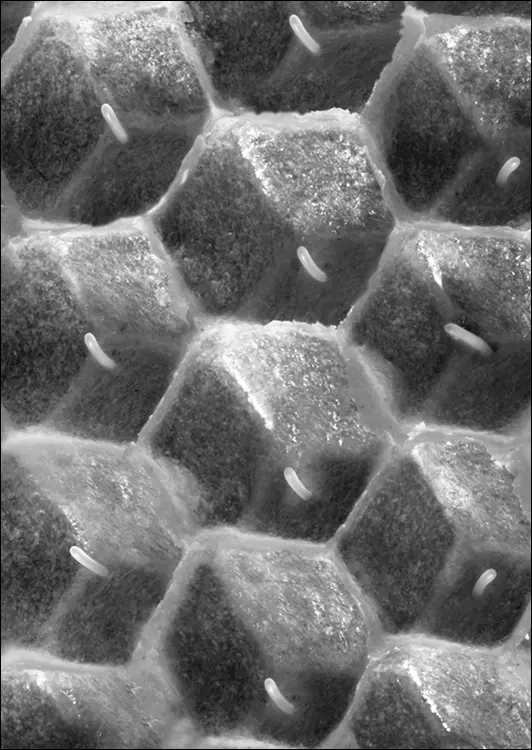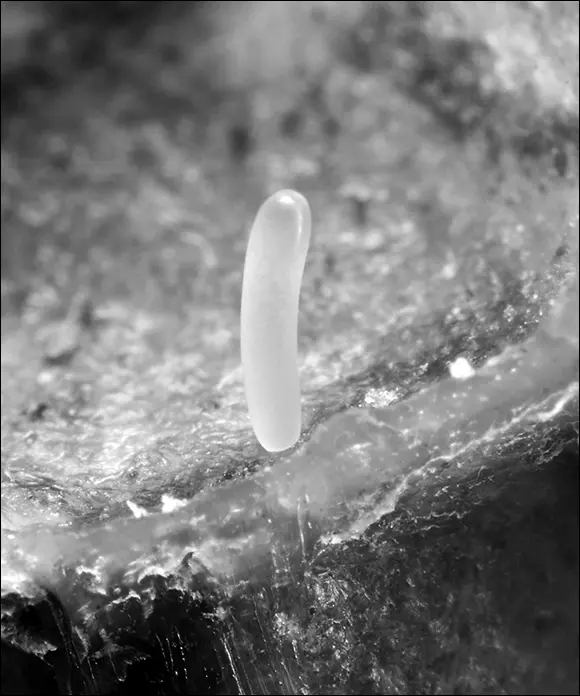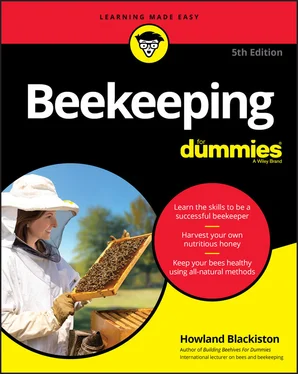FIGURE 2-8:This bee’s pollen baskets are filled. She can visit ten flowers every minute and may visit more than 600 flowers before returning to the hive.
Foraging bees visit 5 million flowers to produce a single pint of honey. They forage a 2- to 3-mile radius from the hive in search of food (even more if necessary for water), and propolis. That’s the equivalent of several thousand acres! So don’t think for a moment that you need to provide everything they need on your property. They’re ready and willing to travel.
Foraging is the toughest time for the worker bee. It’s difficult and dangerous work, and it takes its toll. They can get chilled as dusk approaches and die before they can return to the hive. Sometimes they become a tasty meal for a bird or other insect. You can spot the old girls returning to the hive. They’ve grown darker in color, and their wings are torn and tattered. This is how the worker bee’s life draws to a close working diligently right until the end.
This brings us to the drone, the male bee in the colony. Drones make up a relatively small percentage of the hive’s total population. At the peak of the season, their numbers may be only in the hundreds. You rarely find more than a thousand.
New beekeepers often mistake a drone for the queen, because he is larger and stouter than a worker bee. But his shape is in fact more like a barrel (the queen’s shape is thinner, more delicate, and tapered). The drone’s eyes are huge and seem to cover his entire head. He doesn’t forage for food from flowers — he has no pollen baskets. He doesn’t help with the building of comb — he has no wax-producing glands. Nor can he help defend the hive — he has no stinger. He is not the queen or a worker — merely the drone.
The drone gets a bad rap in many bee books. Described as lazy, glutinous, and incapable of caring for himself, you might even begin wondering what he’s good for.
He mates! Procreation is the drone’s primary purpose in life. Despite their high maintenance (they must be fed and cared for by the worker bees), drones are tolerated and allowed to remain in the hive because they are needed to mate with a new virgin queen from another colony (when the old queen from that other colony dies or needs to be superseded). Mating occurs outside of the hive in mid-flight, 200 to 300 feet in the air. This location is known as the “Drone Congregation Area,” and it can be a mile or more away from the hive. The drone’s big eyes come in handy for spotting virgin queens who are taking their nuptial flights.
The few drones that do get a chance to mate are in for a sobering surprise. They die after mating! That’s because their sex organ fits something like a key into a lock so they can effectively discharge their sperm into the queen.The queen will mate with several drones during her nuptial flight. After mating with the queen, the drone’s most personal apparatus and a significant part of its internal anatomy is torn away, and it falls to its death, a fact that prompts empathetic groans from the men in my lectures and some unsympathetic cheers from a few women.
Once the weather gets cooler and the mating season comes to a close, the workers do not tolerate having drones around. After all, those fellows have big appetites and would consume a tremendous amount of food during the perilous winter months. So in cooler climates at the end of the nectar-producing season, the worker bees systematically expel the drones from the hive. Drones are literally tossed out the door. For those beekeepers who live in areas that experience cold winters, this is your signal that the beekeeping season is over for the year.
Depending on where you live, the calendar of events for you and your bees varies depending on temperature ranges and the time of year. To read more about the beekeeper’s calendar in your part of the world, see the information and chart in Chapter 9.
In regions where winter means “cold,” the hive is virtually dormant. The adult bees are in a tight cluster for warmth, and their queen is snugly safe in the center of it all. But as the days lengthen and the spring season approaches, the bees begin feeding the queen royal jelly. This special food (secreted from the glands near the workers’ mandibles) is rich in protein and stimulates the queen to start laying eggs.
Like butterflies, honey bees develop in four distinct phases: egg, larva, pupa, and adult. The total development time varies a bit among the three types of bees, but the basic miraculous process is the same: 16 days for queens, 21 days for worker bees, and 24 days for drones.
The metamorphosis begins when the queen lays an egg. You should learn how to spot eggs because that is one of the most basic and important skills you need to develop as a beekeeper. It isn’t an easy task because the eggs are mighty tiny (only about 1.7 millimeters long). But finding eggs is one of the surest ways to confirm that your queen is alive and well. It’s a skill you’ll use just about every time you visit your hive.
The queen lays a single egg in each cell that has been cleaned and prepared by the workers to raise new brood (see Figure 2-9). The cell must be spotless, or she moves on to another one.
If she chooses a standard worker-size cell, she releases a fertilized egg into the cell. That egg develops into a worker bee (female). But if she chooses a wider, drone-size cell, the queen releases her egg but not sperm; for example, a nonfertilized egg. That egg develops into a drone bee (male). The workers that build the cells regulate the ratio of female worker bees to male drone bees. They do this by building smaller cells for female worker bees and larger cells for male drone bees.
Having said all that, not all fertilized eggs develop into worker bees. Some can develop into a regal queen bee. But more on that in Chapter 14.
The queen positions the egg in an upright position (standing on end) at the bottom of a cell. That’s why they’re so hard to see. When you look straight down into the cell, you’re looking at the minuscule diameter of the egg, which is only 0.4 millimeter wide. Figure 2-10 shows a microscopic close-up of a single egg.

Courtesy of Howland Blackiston
FIGURE 2-9:Note the rice-like shape of the eggs and how the queen has positioned them standing up in the cells.

Courtesy of Alexander Wild, www.alexanderwild.com
FIGURE 2-10:A single egg.
 Eggs are much easier to spot on a bright, sunny day. Hold the comb at a slight angle, with the sun behind you and shining over your shoulder, illuminating the deep recesses of the cell. The eggs are translucent white and resemble a miniature grain of rice. I recommend that you invest in an inexpensive pair of reading glasses. Better yet, get yourself a pair of magnifying goggles such as those used by watchmakers and model makers (see Figure 2-11).The magnification can really help you spot the eggs (even if you don’t normally need reading glasses). After you discover your first egg, it’ll be far easier to know what you’re looking for during future inspections.
Eggs are much easier to spot on a bright, sunny day. Hold the comb at a slight angle, with the sun behind you and shining over your shoulder, illuminating the deep recesses of the cell. The eggs are translucent white and resemble a miniature grain of rice. I recommend that you invest in an inexpensive pair of reading glasses. Better yet, get yourself a pair of magnifying goggles such as those used by watchmakers and model makers (see Figure 2-11).The magnification can really help you spot the eggs (even if you don’t normally need reading glasses). After you discover your first egg, it’ll be far easier to know what you’re looking for during future inspections.

Courtesy of Howland Blackiston
Читать дальше



 Eggs are much easier to spot on a bright, sunny day. Hold the comb at a slight angle, with the sun behind you and shining over your shoulder, illuminating the deep recesses of the cell. The eggs are translucent white and resemble a miniature grain of rice. I recommend that you invest in an inexpensive pair of reading glasses. Better yet, get yourself a pair of magnifying goggles such as those used by watchmakers and model makers (see Figure 2-11).The magnification can really help you spot the eggs (even if you don’t normally need reading glasses). After you discover your first egg, it’ll be far easier to know what you’re looking for during future inspections.
Eggs are much easier to spot on a bright, sunny day. Hold the comb at a slight angle, with the sun behind you and shining over your shoulder, illuminating the deep recesses of the cell. The eggs are translucent white and resemble a miniature grain of rice. I recommend that you invest in an inexpensive pair of reading glasses. Better yet, get yourself a pair of magnifying goggles such as those used by watchmakers and model makers (see Figure 2-11).The magnification can really help you spot the eggs (even if you don’t normally need reading glasses). After you discover your first egg, it’ll be far easier to know what you’re looking for during future inspections.











